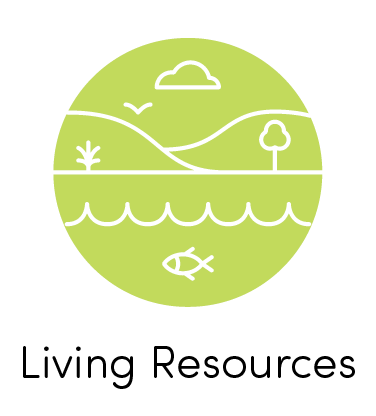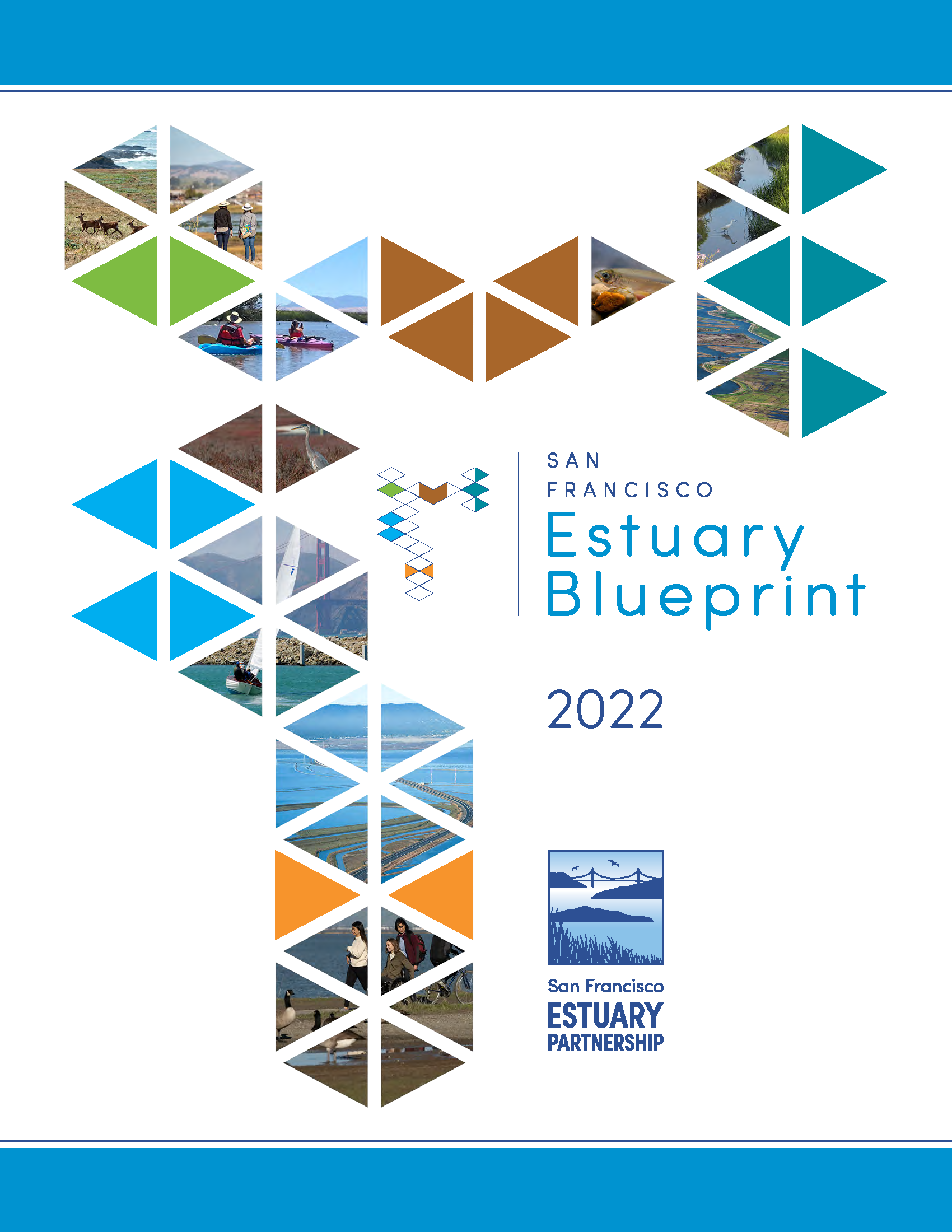Action 15: Invasive Species
← Back to Estuary Blueprint Actions
Minimize the impact of invasive species.
Reduce the impact of invasive species through prevention, early detection, rapid response, eradication, and control. Conduct work with national, state, and regional coordinating bodies and the key agencies implementing specific programs.
Overview
Invasive species threaten native species and the delicate habitats of the Estuary. Prevention is regarded as the first and most important line of defense against invasions. It is critical to continue the work on key pathways/vectors, including ballast water, to reduce the risk of introducing new invaders. If an invader does slip through, this Action calls for key Tasks on Early Detection and Rapid Response (EDRR). Finally, this Action calls for the implementation of eradication and control programs with priority given to species that can be eradicated and/or species that have extensive impacts on habitats important to the health of the estuarine ecosystem.
Task Description
Maintain, expand, and improve invasive species prevention programs (including for ballast water, marine biofouling, trailer boats, and organisms in trade). Actions may include developing new or expanding existing policies and programs, conducting outreach (e.g., to the boating community, Weed Management Area partnerships, etc.) and working with existing entities to identify priority activities.Task Lead(s)
California Department of Fish & Wildlife, California Department of Food & Agriculture, California Invasive Plant Council, California State Lands Commission, San Francisco Estuary Partnership, U.S. Fish & Wildlife ServiceTask Collaborating Partner(s)
California State Coastal Conservancy’s Invasive Spartina Project, California State Parks Division of Boating and Waterways, Central Valley Regional Water Quality Control Board, Delta Conservancy, Delta Stewardship Council, National Oceanic and Atmospheric Administration, PlantRight Partnership, San Francisco Bay National Estuarine Research Reserve, San Francisco Bay Regional Water Quality Control Board, Suisun Resource Conservation District, U.S. Army Corps of Engineers, U.S. Coast Guard, U.S. Department of Agriculture, U.S. Environmental Protection AgencyCost Estimate Key
|
Cost Estimate
$Milestone(s)
Five to seven new or expanded policies or programs, list of priority activities in various programs, and two outreach campaigns implemented through pertinent networks.Task Description
Increase early detection, monitoring, and rapid response programs by identifying additional funding sources and creating a Rapid Response Fund. Monitoring includes: 1) assessing and mapping Estuary-wide distribution of key invasive species; and 2) increasing citizen scientist monitoring through Calflora, iNaturalist, and other similar websites.Task Lead(s)
California Department of Fish & Wildlife, California Invasive Plant Council, California State Coastal Conservancy, U.S. Fish & Wildlife ServiceTask Collaborating Partner(s)
California State Lands Commission, California State Parks Division of Boating and Waterways, Central Valley Regional Water Quality Control Board, Delta Conservancy, Delta Stewardship Council, National Fish and Wildlife Foundation, National Oceanic and Atmospheric Administration, San Francisco Bay National Estuarine Research Reserve, San Francisco Bay Regional Water Quality Control Board, U.S. Army Corps of Engineers, U.S. Department of Agriculture, U.S. Environmental Protection AgencyCost Estimate Key
|
Cost Estimate
$$$Milestone(s)
Rapid response fund established, and three to four funding sources identified for monitoring and/or mapping.Task Description
Develop Early Detection and Rapid Response (EDRR) Frameworks at the local or national scale by setting up a framework to detect and respond to invasive species and a series of sustained and coordinated actions with associated responsible agencies and partners.Task Lead(s)
Delta Conservancy, Delta Stewardship Council, San Francisco Estuary Partnership, U.S. Fish & Wildlife ServiceTask Collaborating Partner(s)
California Department of Fish & Wildlife, California Invasive Plant Council, California State Lands Commission, California State Parks Division of Boating and Waterways, Central Valley Regional Water Quality Control Board, National Oceanic and Atmospheric Administration, San Francisco Bay Regional Water Quality Control Board, U.S. Army Corps of Engineers, U.S. Coast Guard, U.S. Department of Agriculture, U.S. Environmental Protection AgencyCost Estimate Key
|
Cost Estimate
$$Milestone(s)
At least one new EDRR Framework.Task Description
Develop new early detection tools using eDNA (i.e., eDNA meta barcoding) for specific environments and suites of species (i.e., marine species).Task Lead(s)
California Department of Fish & WildlifeTask Collaborating Partner(s)
California Invasive Plant Council, California State Coastal Conservancy’s Invasive Spartina Project, California State Lands Commission, California State Parks Division of Boating and Waterways, Central Valley Regional Water Quality Control Board, Delta Conservancy, Delta Stewardship Council, Moss Landing Marine Lab, National Oceanic and Atmospheric Administration, San Francisco Bay National Estuarine Research Reserve, San Francisco Bay Regional Water Quality Control Board, San Francisco Estuary Partnership, Smithsonian Environmental Research Center, U.S. Army Corps of Engineers, U.S. Coast Guard, U.S. Department of Agriculture, U.S. Environmental Protection Agency, U.S. Fish & Wildlife ServiceCost Estimate Key
|
Cost Estimate
$$Milestone(s)
One to three techniques for early detection, such as pilot eDNA meta barcoding or other eDNA techniques.Task Description
Implement eradication and control programs with priority given to species that can be eradicated and/or species that have extensive impacts on habitats important to the health of the estuarine ecosystem. Research and test pilot control measures for key invasive species.Task Lead(s)
California Invasive Plant Council, California State Coastal ConservancyTask Collaborating Partner(s)
California Department of Fish & Wildlife, California State Parks Division of Boating and Waterways, Central Valley Regional Water Quality Control Board, Delta Conservancy, Delta Stewardship Council, National Oceanic and Atmospheric Administration, San Francisco Bay National Estuarine Research Reserve, San Francisco Bay Regional Water Quality Control Board, California State Coastal Conservancy,’s Invasive Spartina Project, U.S. Army Corps of Engineers, U.S. Department of Agriculture, U.S. Fish & Wildlife ServiceCost Estimate Key
|
Cost Estimate
$$$Milestone(s)
For two to five key invasive species, total acreage of species reduced and/or number of acres being managed to reduce species increased.Task Description
Ensure regulatory agencies and project proponents include requirements to prevent the introduction and spread of invasive species, including using native-only plant lists, using sources with a clean supply of native plant species that are free of pathogens, and confirming that Best Management Practices (BMPs) are shared for invasive species where they exist (for example: Invasive Spartina Project BMPs 2016, California State Lands Commission’s BMPs for marina leases).Task Lead(s)
California State Coastal ConservancyTask Collaborating Partner(s)
Bay Restoration Regulatory Integration Team (BRRIT), California Department of Fish & Wildlife, California Invasive Plant Council, California State Lands Commission, Central Valley Regional Water Quality Control Board, Delta Conservancy, Delta Stewardship Council, National Oceanic and Atmospheric Administration, San Francisco Bay Conservation & Development Commission, San Francisco Bay Regional Water Quality Control Board, U.S. Army Corps of Engineers, U.S. Department of Agriculture, U.S. Environmental Protection Agency, U.S. Fish & Wildlife ServiceCost Estimate Key
|
Cost Estimate
$$Milestone(s)
Number of permits or leases with improved native and invasive species requirements increased.Task Description
Finalize Best Management Practices (BMPs) for reducing the spread of aquatic invasive species through biofouling of mobile marine infrastructure (MMI) in collaboration with regulatory agencies for incorporation into permits.Task Lead(s)
Coastal Committee of the Western Regional Panel on Aquatic Nuisance Species, San Francisco Estuary PartnershipTask Collaborating Partner(s)
California Department of Fish & Wildlife, California State Lands Commission, Central Valley Regional Water Quality Control Board, Delta Conservancy, Delta Stewardship Council, Federal Aquatic Nuisance Species Task Force, National Oceanic and Atmospheric Administration, San Francisco Bay Conservation & Development Commission, San Francisco Bay Regional Water Quality Control Board, U.S. Army Corps of Engineers, U.S. Coast Guard, U.S. Department of Agriculture, U.S. Environmental Protection Agency, U.S. Fish & Wildlife ServiceCost Estimate Key
|
Cost Estimate
$$Milestone(s)
Final BMPs released for reducing the spread of aquatic invasive species through biofouling of mobile marine infrastructure.Task Description
Task Lead(s)
Task Collaborating Partner(s)
Cost Estimate Key
|
Cost Estimate
Milestone(s)
Updates and Emerging Issues
This Action continues to support activities through existing bodies such as the Federal Aquatic Nuisance Species Task Force, the Western Regional Panel on Aquatic Nuisance Species, and Pacific Ballast Water Group, just to name a few. This Action has also included new Tasks and Milestones such as the pilot use of eDNA for early detection, the development of an EDRR framework, and finalizing Best Management Practices (BMPs) for reducing the spread of aquatic invasive species through biofouling of mobile marine infrastructure.
Climate Change Considerations
Climate change can exacerbate the proliferation of many invasive species in the Estuary due to warmer temperatures and longer growing seasons. Ecological resilience to climate change can be improved by preventing the adverse impacts of invasive species, making it even more urgent to implement the prevention and EDRR tasks in this Action.
Equity Considerations
Invasive species may displace culturally significant plants and animals for Tribes and can interfere with significant activities — such as subsistence fishing — on which vulnerable populations might rely. In addition, invasive species control and eradication efforts can have unintended economic and other impacts on frontline and underserved communities if an equity lens is not applied.
Blueprint Goals

Connections to Other Actions
Watershed connections provide unique habitat and ecosystem services closely related to or dependent upon:
Action 5: Watershed Connections
Action 6: Sediment
Action 9: Intertidal / Subtidal Habitats
Action 10: Tidal Marsh
Action 11: Transition Zones
Action 12: Managed Wetlands
Action 13: Seasonal Wetlands
Action 14: Creeks
